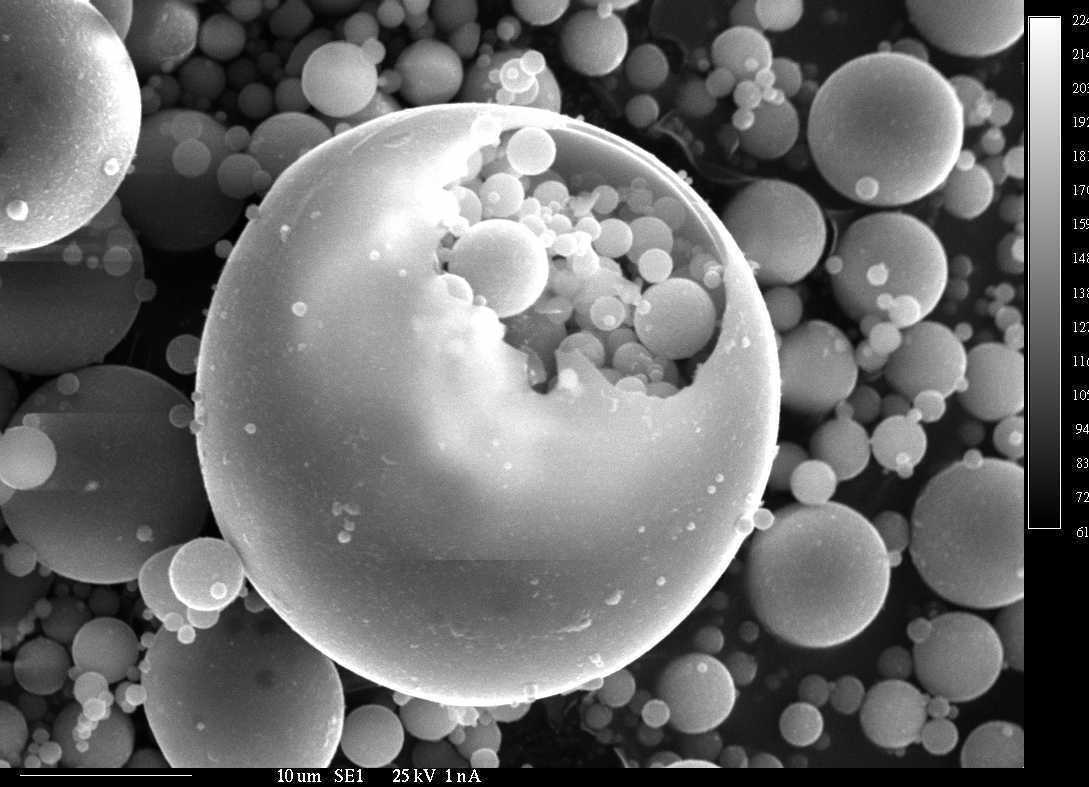Note: Kevin D. Copeland is the Manager of Quality & Technical Services at Boral Material Technologies in San Antonio, Texas.
What is fly ash?
Fly ash closely resembles volcanic ashes used in production of the earliest known hydraulic cements about 2,300 years ago. Those cements were made near the small Italian town of Pozzuoli – which later gave its name to the term pozzolan. A pozzolan is a siliceous/aluminous material that, when mixed with lime and water, forms a cementitious compound. Fly ash is the best known, and one of the most commonly used, pozzolans in the world.
Instead of volcanoes, today’s fly ash comes primarily from coal-fired, electricity-generating power plants. These power plants grind coal to powder fineness before it is burned. Fly ash – the mineral residue produced by burning coal – is captured from the power plant’s exhaust gases and collected for use.
The difference between fly ash and portland cement becomes apparent under a microscope. Fly ash particles are almost totally spherical in shape, allowing them to flow and blend freely in mixtures. That capability is one of the properties making fly ash a desirable admixture for concrete.
Why use fly ash in concrete?
First of all, the spherical shape of fly ash creates a ball bearing effect in the mix, improving workability without increasing water requirements. Fly ash also improves the pump-ability of concrete by making it more cohesive and less prone to segregation. The spherical shape improves the pump-ability by decreasing the friction between the concrete and the pump line. In addition, some fly ashes have been shown to significantly decrease heat generation as the concrete hardens and strengthens. Fly ash, as do all pozzolanic materials, generally provide increased concrete strength gain for much longer periods than mixes with portland cement only.
The biggest reason to use fly ash in concrete is the increased life cycle expectancy and increase in durability associated with its use. During the hydration process, fly ash chemically reacts with the calcium hydroxide forming calcium silicate hydrate and calcium aluminate, which reduces the risk of leaching calcium hydroxide and concrete’s permeability. Fly ash also improves the permeability of concrete by lowering the water-to-cement ratio, which reduces the volume of capillary pores remaining in the mass. The spherical shape of fly ash improves the consolidation of concrete, which also reduces permeability.
Other benefits of fly ash in concrete include resistance to corrosion of concrete reinforcement, attack from Alkali-silica reaction, sulfate attack and acids and salt attack.
How much fly ash in concrete?
Typically, concrete designers use fly ash as a partial replacement for portland cement at values up to 30 percent of the total cementitious composition. The use of high percentages (high volumes) of fly ash has been studied extensively over the last 15 years, and the benefits of this type of concrete have been well documented. When properly designed and constructed, the increased benefits of concrete made with 40, 50 and 60 percent fly ash replacement include dramatically reduced concrete permeability and excellent resistance to all forms of premature deterioration. [For Monolithic Dome construction specifics, see Editor’s Note below.]
The use of high volume fly ash concrete has gained increasing acceptance by structural engineers and architects from an environmental standpoint, as well as the life cycle cost approach. When designing and specifying concrete for strength and durability, the proper selection of constituent materials depends on the exposure conditions, type of structure and intended use. For applications such as footings, columns, walls and beams, where surface exposure is minimal, high volume fly ash concrete mixes may be used effectively. For mass concrete placements such as mat or raft foundations, the use of even higher quantities of fly ash is recommended.
Cost of fly ash
Fly ash typically costs approximately 1/2 to 2/3 that of portland cement as delivered, assuming a suitable means of batching is already in place.
December 2, 2003
Editor’s Note: At Monolithic, we recommend that 100 pounds of cement be left out of our normal shotcrete mix and replaced with 120 pounds of fly ash. This we do when using ready-mixed cement. When mixing onsite, we rarely use fly ash due to its difficulty in handling. Fly ash contributes considerably to the ultimate strength of the concrete and makes it easier to pump.
